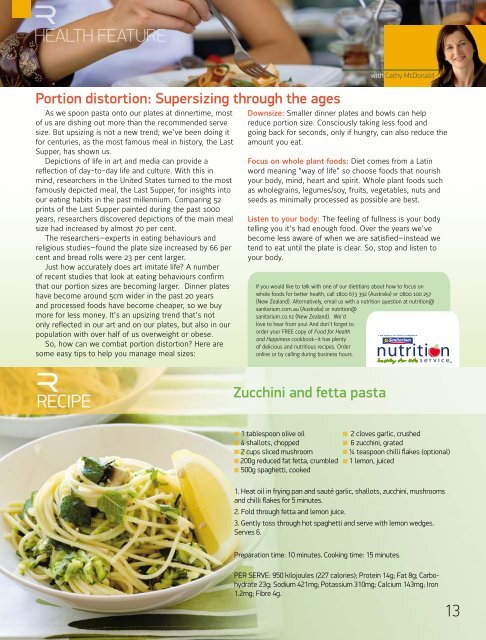Download the Record as a PDF
Download the Record as a PDF
Download the Record as a PDF
You also want an ePaper? Increase the reach of your titles
YUMPU automatically turns print PDFs into web optimized ePapers that Google loves.
HEALTH FEATURE<br />
Portion distortion: Supersizing through <strong>the</strong> ages<br />
As we spoon p<strong>as</strong>ta onto our plates at dinnertime, most<br />
of us are dishing out more than <strong>the</strong> recommended serve<br />
size. But upsizing is not a new trend; we’ve been doing it<br />
for centuries, <strong>as</strong> <strong>the</strong> most famous meal in history, <strong>the</strong> L<strong>as</strong>t<br />
Supper, h<strong>as</strong> shown us.<br />
Depictions of life in art and media can provide a<br />
reflection of day-to-day life and culture. With this in<br />
mind, researchers in <strong>the</strong> United States turned to <strong>the</strong> most<br />
famously depicted meal, <strong>the</strong> L<strong>as</strong>t Supper, for insights into<br />
our eating habits in <strong>the</strong> p<strong>as</strong>t millennium. Comparing 52<br />
prints of <strong>the</strong> L<strong>as</strong>t Supper painted during <strong>the</strong> p<strong>as</strong>t 1000<br />
years, researchers discovered depictions of <strong>the</strong> main meal<br />
size had incre<strong>as</strong>ed by almost 70 per cent.<br />
The researchers—experts in eating behaviours and<br />
religious studies—found <strong>the</strong> plate size incre<strong>as</strong>ed by 66 per<br />
cent and bread rolls were 23 per cent larger.<br />
Just how accurately does art imitate life? A number<br />
of recent studies that look at eating behaviours confirm<br />
that our portion sizes are becoming larger. Dinner plates<br />
have become around 5cm wider in <strong>the</strong> p<strong>as</strong>t 20 years<br />
and processed foods have become cheaper, so we buy<br />
more for less money. It’s an upsizing trend that’s not<br />
only reflected in our art and on our plates, but also in our<br />
population with over half of us overweight or obese.<br />
So, how can we combat portion distortion? Here are<br />
some e<strong>as</strong>y tips to help you manage meal sizes:<br />
with Cathy McDonald<br />
Downsize: Smaller dinner plates and bowls can help<br />
reduce portion size. Consciously taking less food and<br />
going back for seconds, only if hungry, can also reduce <strong>the</strong><br />
amount you eat.<br />
Focus on whole plant foods: Diet comes from a Latin<br />
word meaning “way of life” so choose foods that nourish<br />
your body, mind, heart and spirit. Whole plant foods such<br />
<strong>as</strong> wholegrains, legumes/soy, fruits, vegetables, nuts and<br />
seeds <strong>as</strong> minimally processed <strong>as</strong> possible are best.<br />
Listen to your body: The feeling of fullness is your body<br />
telling you it’s had enough food. Over <strong>the</strong> years we’ve<br />
become less aware of when we are satisfied—instead we<br />
tend to eat until <strong>the</strong> plate is clear. So, stop and listen to<br />
your body.<br />
If you would like to talk with one of our dietitians about how to focus on<br />
whole foods for better health, call 1800 673 392 (Australia) or 0800 100 257<br />
(New Zealand). Alternatively, email us with a nutrition question at nutrition@<br />
sanitarium.com.au (Australia) or nutrition@<br />
sanitarium.co.nz (New Zealand). We’d<br />
love to hear from you! And don’t forget to<br />
order your FREE copy of Food for Health<br />
and Happiness cookbook—it h<strong>as</strong> plenty<br />
of delicious and nutritious recipes. Order<br />
online or by calling during business hours.<br />
RECIPE<br />
Zucchini and fetta p<strong>as</strong>ta<br />
1 tablespoon olive oil 2 cloves garlic, crushed<br />
4 shallots, chopped 6 zucchini, grated<br />
2 cups sliced mushroom ¼ te<strong>as</strong>poon chilli flakes (optional)<br />
200g reduced fat fetta, crumbled 1 lemon, juiced<br />
500g spaghetti, cooked<br />
1. Heat oil in frying pan and sauté garlic, shallots, zucchini, mushrooms<br />
and chilli flakes for 5 minutes.<br />
2. Fold through fetta and lemon juice.<br />
3. Gently toss through hot spaghetti and serve with lemon wedges.<br />
Serves 6.<br />
Preparation time: 10 minutes. Cooking time: 15 minutes.<br />
PER SERVE: 950 kilojoules (227 calories); Protein 14g; Fat 8g; Carbohydrate<br />
23g; Sodium 421mg; Pot<strong>as</strong>sium 310mg; Calcium 143mg; Iron<br />
1.2mg; Fibre 4g.<br />
13

















